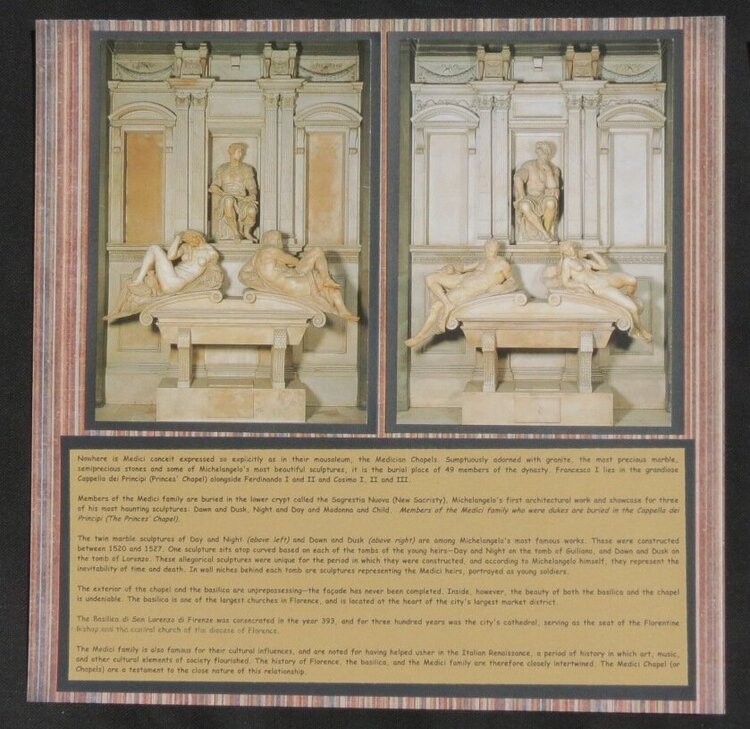Plus, a FREE Gift! | Details Here.


 Give a Cheer
Give a Cheer
Nowhere is Medici conceit expressed so explicitly as in their mausoleum, the Medician Chapels. Sumptuously adorned with granite, the most precious marble, semiprecious stones and some of Michelangelo's most beautiful sculptures, it is the burial place of 49 members of the dynasty. Francesco I lies in the grandiose Cappella dei Principi (Princes' Chapel) alongside Ferdinando I and II and Cosimo I, II and III.
Members of the Medici family are buried in the lower crypt called the Sagrestia Nuova (New Sacristy), Michelangelo's first architectural work and showcase for three of his most haunting sculptures: Dawn and Dusk, Night and Day and Madonna and Child. Members of the Medici family who were dukes are buried in the Cappella dei Principi (The Princes' Chapel).
The twin marble sculptures of Day and Night (above left) and Dawn and Dusk (above right) are among Michelangelo's most famous works. These were constructed between 1520 and 1527. One sculpture sits atop curved based on each of the tombs of the young heirs—Day and Night on the tomb of Guiliano, and Dawn and Dusk on the tomb of Lorenzo. These allegorical sculptures were unique for the period in which they were constructed, and according to Michelangelo himself, they represent the inevitability of time and death. In wall niches behind each tomb are sculptures representing the Medici heirs, portrayed as young soldiers.
The exterior of the chapel and the basilica are unprepossessing—the façade has never been completed. Inside, however, the beauty of both the basilica and the chapel is undeniable. The basilica is one of the largest churches in Florence, and is located at the heart of the city's largest market district.
The Basilica di San Lorenzo di Firenze was consecrated in the year 393, and for three hundred years was the city's cathedral, serving as the seat of the Florentine Bishop and the central church of the diocese of Florence.
The Medici family is also famous for their cultural influences, and are noted for having helped usher in the Italian Renaissance, a period of history in which art, music, and other cultural elements of society flourished. The history of Florence, the basilica, and the Medici family are therefore closely intertwined. The Medici Chapel (or Chapels) are a testament to the close nature of this relationship.
No products have been added to this project.
Thanks for spreading positivity!
January 04, 2014
December 08, 2013
December 07, 2013
December 07, 2013
December 07, 2013
December 06, 2013
December 06, 2013
December 06, 2013
December 06, 2013
December 05, 2013
December 04, 2013
December 04, 2013